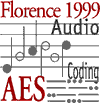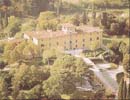
AES 17th Conference
High Quality Audio Coding
1999, September 2nd-5th

Villa Castelletti
Signa (near Florence)
Italy
Tutorials
Tutorials
- Tutorial 1 - General Overview and Psychoacoustics
Friday, September 3 / 11:15 am - 12:15 am
James Johnston, AT&T - Research, Florham Park, NJ, USA - In this tutoral session we will present an overview of the basics of perceptual coding, including
the usual blocks in a coder, for later reference during the rest of the tutorial sessions.
After that, we will present a brief overview, mostly from the observed/measurement side rather than the theoretical modelling side, of human hearing, concentrating on current understanding in masking theory. We will discuss cochlear filtering, critical bands (and their relationship to cochlear filtering), masking results, and some material on the current hypotheses for the cause of masking. Our emphasis will be on aspects of the auditory system that create problems or advantages for perceptual coders. - Tutorial 2 - Filter Banks in Perceptual Audio Coding
Saturday, September 4 / 9:30 am - 10:15 am
Marina Bosi, Digital Theater Systems,Inc., CA, USA - This paper presents an overview of the filter-bank technologies used in the time to frequency mapping of perceptual audio coders. Filter banks allow for signal decorrelation and therefore provide a framework for removing redundancy in an audio signal. In addition, irrelevant components of the signal can be separated from relevant ones based on models of human perception. In this paper, filter-bank design and implementation issues are discussed. Time versus frequency resolution and filter banks in which the time-invariant constraint is relaxed will be described. Finally other methods for increasing redundancy extraction, such as prediction, will be examined.
- Tutorial 3 - Temporal Noise Shaping, Quantization and
Coding Methods in Perceptual Audio Coding: A Tutorial Introduction
Sunday, September 5 / 9:30 am - 10:15 am
Jürgen Herre, Fraunhofer Institut für Integrierte Schaltungen, Erlangen, Germany - Perceptual audio coding has become an important key technology for many types of multimedia services these days. This paper provides a brief tutorial introduction into a number of issues as they arise in today's low bitrate audio coders. After discussing the Temporal Noise Shaping technology in the first part of this paper, the second part will focus on the large number of possible choices for the quantization and coding methods for perceptual audio coding along with examples of real-world systems using these approaches.
